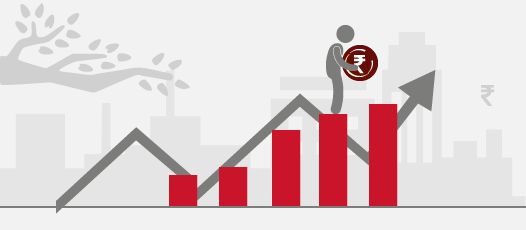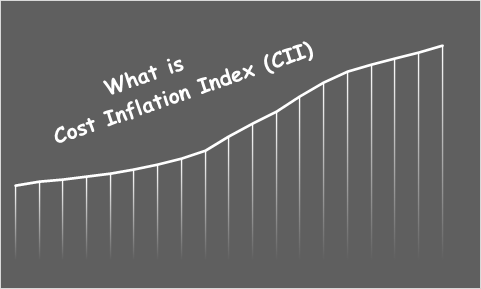Introduction
Cost Inflation Index (CII) is used to estimate the increase in the prices of goods and assets year-by-year due to inflation. It is issued by the central government of India in their official gazette.

This index comes under section 48, of the Income Tax Act, 1961.
The value of the rupee today will not stay the same for tomorrow. The prices keep increasing due to inflation. It is fair to pay more for toothbrushes over the years because of the price rise. Likewise, it is not fair to pay Capital Gain Tax without incorporating the factor of inflation.
Capital gain is the profit you make on selling an asset. It can be real estate, stock, mutual funds, jewelry, etc. If you are selling the asset after 36 months from the date of purchase, it becomes a long-term capital gain. If you are selling an asset after one year from the date of its purchase, the profit becomes a short-term capital gain. The government charges tax on our sale of the asset and they do not wish to let go of the capital gain. Hence, the government charges capital gains tax. Cost inflation index India is an index issued by the Central Board of Direct Taxes and the figures keep changing every financial year.
How is Cost Inflation Index calculated
Cost Inflation Index is calculated to match the prices to the inflation rate. In simple words, an increase in the inflation rate over time will lead to a rise in the prices.
Consumer Price Index compares the current price of a basket of goods and services (which represent the economy) with the cost of the same basket of goods and services in the previous year to calculate the increase in prices.
It is an index used to calculate the notional increase in the value of an asset due to inflation. There are two things that individuals need to keep in mind regarding the cost inflation index.
Firstly, this number will be used to calculate inflation-adjusted cost only for those assets where inflation-adjusted (indexation benefit) is allowed. Therefore, the CII value cannot be used to arrive at LTCG/LTCL on equity mutual funds as the amount that exceeds Rs 1 lakh per fiscal is taxed at a flat rate of 10 per cent without indexation benefit.
Secondly, this CII number will be required to calculate LTCG for FY 2020-21 for the assets where indexation is allowed before levy of LTCG tax. The taxes on these gains will be paid by you while filing your income tax returns (ITR) for FY 2020-21 (AY 2021-22).
The base year is the first year in the index whose value is set at 100. The indexation of years following the base year i s done in accordance with the base year to check their increasing the inflation percentage.
The formula to calculate the cost inflation index is as follows:
Cost Inflation Index (CII) = CII for the year the asset was transferred or sold / CII for the year the asset was acquired or bought
- In case of property received in the will, CII has to be taken for the year in which the property is received. Actual purchase year of the property has to be ignored.
- Ignore the improvement cost incurred before 1st April 2001.
- Index benefit is not allowed in case of bonds or debentures except capital indexation bonds or sovereign gold bonds issued by RBI.
CII for the Years
The cost inflation index for FY 2020-21 is 301. Check for other financial year’s CII Value.
| Financial Year | CII |
|---|---|
| 2009-10 | 148 |
| 2010-11 | 167 |
| 2011-12 | 184 |
| 2012-13 | 200 |
| 2013-14 | 220 |
| 2014-15 | 240 |
| 2015-16 | 254 |
| 2016-17 | 264 |
| 2017-18 | 272 |
| 2018-19 | 280 |
| 2019-20 | 289 |
| 2020-21 | 301 |
The Cost Inflation Index (CII) for the financial year 2021-22 is 317.
Example
Suppose, you purchased an apartment for Rs.10 lakhs in Jan 2000 and sold it for Rs.15 lakhs in Jan 2009. Your profit or capital gain is Rs.5 lakhs.
The CII for the year the apartment was bought in is 389. The CII for the year the apartment was sold in is 582.
The cost inflation index is 582/389 = 1.49
While computing tax, CII is multiplied with the purchase price to arrive at the indexed cost of acquisition. This is the actual cost of the asset.
Therefore, the indexed cost of acquisition = 10,00,000 X 1.49 = Rs.14,96,144
The long term capital gain= sale value of the asset- indexed cost of acquisition i.e., 15,00,00- 14,96,144 = Rs.3,856
The tax liability if you use the indexation method is charged at 20 percent. The tax liability will be 20% X 3,856 = Rs.771.2
If you do not use the indexation method, the tax is liable at 10% on the capital gain. The capital in this case is sale price of the apartment – cost of acquisition = 15,00,000 – 10,00,000 = Rs.5,00,000. The capital gains tax is 10% X 5,00,000 = Rs.50,000.
When you index, it helps you save taxes. It helps you adjust the purchasing price of the apartment with the current market prices.
Conclusion
Cost Inflation Index (CII) is one of the most important economic indicators for an economy, as it is used to calculate inflation. All the other factors influenced by the CII are mentioned in the different sections in the article.




